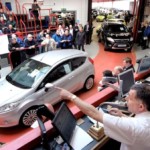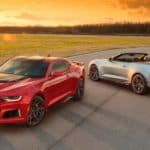On September 23rd, Governor Gavin Newsom of California issued an executive order that will require all passenger vehicles sold in the state, starting in 2035, be zero-emission vehicles. In other words, starting in 2035, by this order, all vehicles sold as new in California will have to be zero-emission models, which right-now essentially means electric cars, trucks, and SUVs. Some people cheered this news, others freaked out about it, and ultimately it will certainly impact car sales in California over the next couple of decades.
But by how much? Let’s take a look at what Governor Newsom’s executive order means, exactly, for the people of California and their shopping options. Whether you live in Cali now or you’re considering a move in the future, or you just like to stay on top of what’s happening in terms of climate change, emissions, and the auto industry, this is something you should know about. It’s certainly not as dire as some people have suggested, but it will impact the auto industry in some pretty interesting ways.
The Executive Order
Let’s start by taking a look at the executive order and what it does exactly. I’m not about to quote the whole thing here because you don’t want to read that, but the basics are the following:
-
- All passenger vehicles sold as new starting in 2035 must be zero-emission models
- All medium and heavy-duty vehicles operated starting in 2045 must be zero-emission where feasible; though it starts in 2035 for “drayage trucks”
- State agencies, partnered with private businesses, are to deploy a substantial number of affordable fueling and charging options for drivers
- Legislature is to end the issuance of new hydraulic fracturing permits by 2024
- State agencies are to develop strategies for an integrated, statewide rail and transit network, with support for bicycle and pedestrian options
If you’re looking to buy a car in California any time in the next 20 years, it’s really only those first couple that you need to be aware of and that second one only if you operate or require powerful, commercial trucks. In particular, it’s that first note that has so many people excited or riled up, depending on their feelings on the subject.

What About Between Now and 2035?
As you can see, the bulk of this order won’t go into effect until 2035, so what about from now to then? Unless anything changes, this has absolutely no direct impact on car sales or options for car buyers in the next 14 years. Right up until December 31st, 2034, you’ll be able to happily buy a brand-new internal combustion vehicle in California without issue. In fact, you can bet that some manufacturers and dealerships are going to bank on this, and over the next 14ish years, there will be plenty of “get a non-electric car now, while you can” deals and sales going on.
Are There Any Exemptions?
There are a couple of noteworthy exemptions to this order, both within the specific language of it and via what’s not mentioned. First, there is the fact that medium-duty and heavy-duty trucks, like a lot of commercial trucks, are exempt from this order until 2045. So if you need large commercial trucks for your business, it will be more than two decades before you need to worry about them being zero-emission models.
The one noteworthy exception to this exemption (ugh!) is vehicles referred to as “drayage trucks” within the order. These are trucks used for shipping goods over relatively short distances, such as you’ll often see transporting products throughout California. Exactly which specific types of vehicles come under this stipulation is likely open to interpretation and will certainly be argued about over the next 14 years.
I’d argue that the biggest, perhaps most important, exemption to this executive order comes in the fact that it specifically says “new passenger cars and trucks.” The word “new” in there makes it very clear that this only refers to the sale of brand-new vehicles. Used models will be able to continue to be sold even in 2035, both by dealerships and by private sellers. This is a big deal, and it’s really going to impact how cars are sold as we get closer to the 2035 deadline.
I don’t think there’s going to be a run on used cars tomorrow––I could be wrong, but I highly doubt it. That, in my opinion, will start in 2035…

How Will This Impact the Auto Industry in California?
As I said, this won’t have a massive impact on things right now. The 2035 deadline is quite far out, so while some manufacturers and dealerships will have this in the back of their minds, no one is making any big moves today because of this order. However, I think it will have a ripple effect that grows over the next decade or so.
Some people will probably see this order and decide it’s the catalyst they need to check out an electric car and perhaps even buy one as their next vehicle. There are always early adopters with this sort of thing: people who want to get ahead of the curve or not have to worry about it later. So I think that’s something the auto industry is going to watch for, and there will be a pronounced effort to appeal to these sorts of buyers over the next decade.
On the other hand, there’s also going to be a push to “get them while you can.” I mentioned this before, but I think it’s going to be one of the most overt and direct things we see: dealerships and manufacturers pushing traditional engines as people have a final opportunity to buy one in California. It’s also worth mentioning, of course, that this is only an order in California, which neighbors three other states along its border. Right now, the language does not impact people who already own a non-EV model or that come into the state with one. So nothing will stop people from heading to Arizona or Nevada to buy a car that’s not zero-emission and then take it back home in California. In fact, I imagine we might see some dealerships pop up quite close to the California border for exactly this reason.
What Do You Need to Know as a Car Buyer?
For the most part, this doesn’t impact you right now, even if you’re a car buyer in California, because it’s still quite a long way off. It’s also worth noting that this is not a bill that was passed into law, but an executive order from the Governor. There’s always the possibility that in the next 14 years, another governor or the legislature will repeal this order or change it in any number of ways.
For the most part, however, I think this is a sign of things to come across the country and perhaps the world. California might not always be a leader in everything, but these kinds of trends have a way of passing from one state to another (look at the legalization of marijuana). Manufacturers that are focusing on electric vehicles, or moving into it, are going to encourage this sort of thing from more states. So getting used to the idea, and perhaps even preparing for an all-electric vehicular future, is probably wise.



